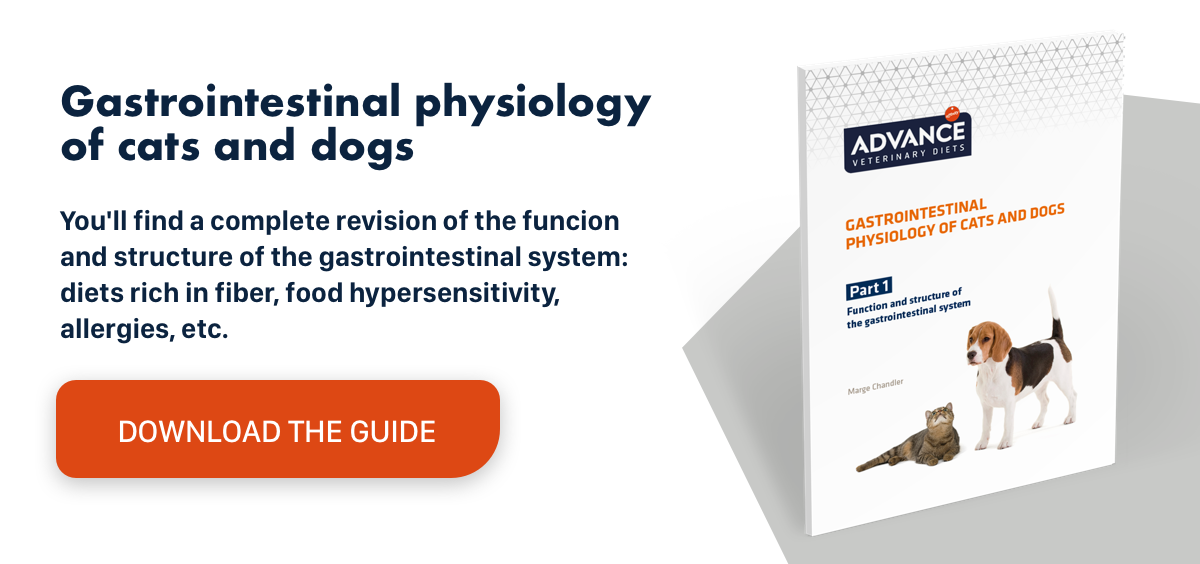What causes gastroenteritis in cats?
Causes
Acute gastroenteritis is a short-lived inflammatory process affecting the stomach and intestine in cats and dogs. It a common complaint in clinical practice and several aetiologies have been recognised.1
The various causes are common to all breeds and ages; however, young animals are more susceptible to parasitic agents (Coccidia, Giardia, various nematodes), obstructions due to foreign bodies, intussusception and viral agents, such as feline panleukopaenia virus. Adults are more prone to metabolic disorders (e.g., liver failure, kidney failure, acute pancreatitis, pyometra and decompensated diabetes) and adverse reactions to medications (e.g., both steroidal and non-steroidal anti-inflammatory drugs), among others.1
Diagnosis
Collect information about species, breed, sex and age, due to the habits of puppies. It is important to assess the environment, the state of other animals cohabiting with the patient, overcrowding and potentially having been in a shelter or kennel/cattery recently because of the increased chance of having contracted a contagious infectious disease.1
Diagnosis requires a detailed anamnesis with an emphasis on vaccination, deworming, dietary changes, pica and the possibility of having ingested toxic substances. Also ask about the onset of signs, the patient’s appetite, or lack thereof, and evolution of the clinical picture. The frequency and type of stools, the presence of mucus or fresh blood in faeces, tenesmus and small volumes can all be used as guides when dealing with disorders of the large intestine.1
A high volume of diarrhoea and the presence of melena could be signs of a problem with the small intestine. Abdominal masses felt during palpation would lead us to suspect foreign bodies, intussusceptions, tumours, granulomas (rare) or organomegaly (liver, spleen, kidney, ovaries). Matted bowel loops are suggestive of adhesions (often postsurgical) or ingestion of linear foreign bodies (common in cats). Enlarged mesenteric lymph nodes may be due to inflammatory processes, bacterial infections, fungal infections or neoplasms.1
Routine laboratory tests should be carried out to check for possible problems and faeces should be examined directly for parasites and fresh or digested blood.1
A stool culture is indicated for the suspicion of a bacterial intestinal infection, such as Salmonella or Campylobacter. However, as some carriers are asymptomatic and many bacteria are considered normal inhabitants of the intestinal lumen, we still haven’t made a solid connection between the disease and the presence of the bacteria. A stool culture is particularly important when many animals are affected simultaneously (e.g., in shelters, hospitalisation, overcrowding or a risk of zoonosis).1
Radiology studies with plain and contrast X-rays can confirm or rule out the presence of foreign bodies, intussusceptions or abdominal masses. Ultrasound can complement the X-rays, providing important information on possible foreign bodies, intussusceptions or lymphadenopathies, and about the absence or presence of peristalsis and the thickness of the intestinal and stomach walls, as well as luminal contents.1
In many cases, the cause of acute gastroenteritis cannot be determined, so patients are given symptomatic, maintenance therapy.1
The importance of diet
It is of the utmost importance to ensure digestive rest from solids and liquids for 24–48 hours to prevent intestinal abrasion by food and colonisation of the intestinal lumen by foreign bacteria, to avoid sensitisation to intact dietary antigens and to allow intestinal disaccharidases to recover. When vomiting ceases, small volumes of liquid should be given orally to test the patient’s digestive tolerance. If this is accepted without problem, patients should receive a low-allergen, low-residue diet that is easily digested and absorbed in the small intestine.1
Cats can be given lean meat or other options such as soy or boiled eggs.1
Small amounts of food should be administered 6–8 times a day to avoid osmotic overload, which could stimulate diarrhoea. This must be maintained for 5–7 days or until normal stool formation is achieved, followed by a gradual return to the patient’s usual diet.1
